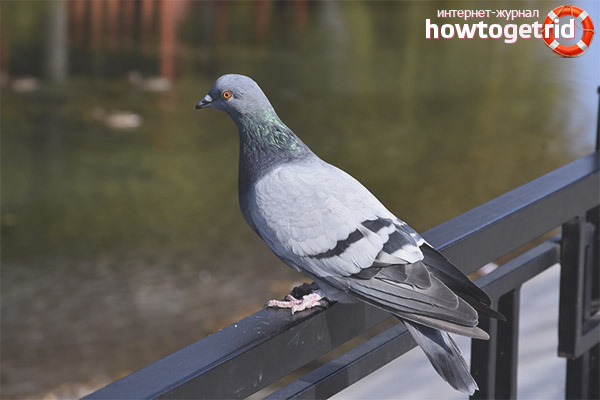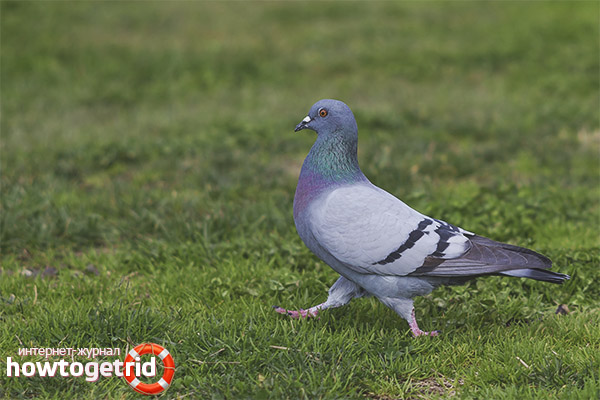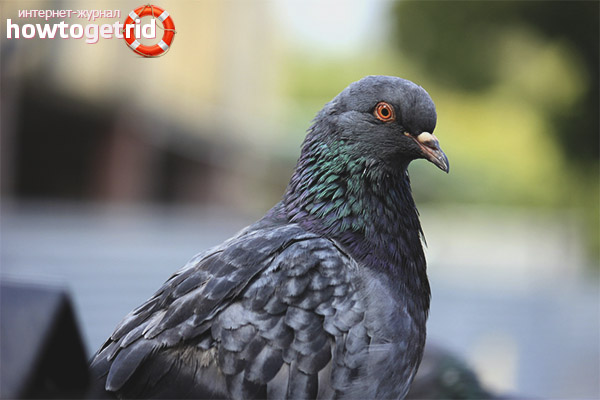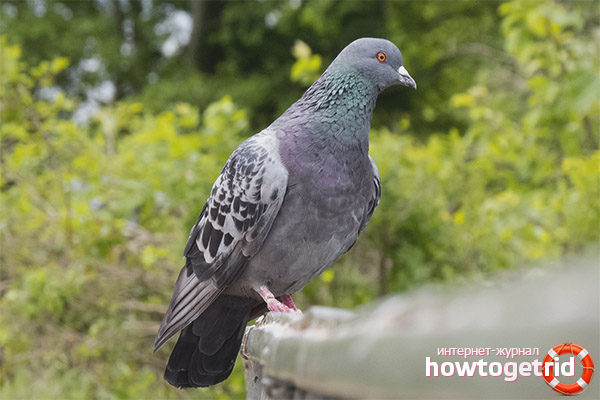The content of the article
The length of the cisar’s body is about 35 centimeters, their body weight varies from 200 to 400 grams, depending on the place of residence and quality of life.
Description of appearance
It is very easy to distinguish cesar from a clintukha that is close in appearance to it, if you know that the first one has orange eyes, a black beak and a white spot on the lower back, but it is not always found. Therefore, this is not the most reliable sign.
Sizars are classified as sedentary birds, they are always attached to certain territories, in which they spend most of their lives.
Most often, pigeons live in colonies, which can number up to 1000 individuals. And the general population around the world has long crossed the line of a million representatives of the species. Moreover, with the onset of cold weather, the population is greatly reduced, and in the summer comes to the original number.
There are several types of cooing pigeons:
- nesting;
- cooing showing courtship;
- hazard warning;
- cooing when feeding.
The color and plumage of sisar
The most common color of pigeons is blue. But there are still many other colors. For example, some city pigeons have very dark or almost black colors, it is rare to find individuals with a coffee-colored plumage. The birds that a person bred can be as brown or completely white, sometimes their beak color is pink and their eyes are dark rather than orange like ordinary sizars. Those who live on the outskirts of cities or in the countryside can be found in a “wild” color, that is, when there are several black stripes on the wings, as well as a dark strip on the gray tail.
Habitat
The behavior of pigeons varies depending on whether they are wild or live in cities.
Wild sizars often wander, though not over long distances, because of the search for food, but urban ones are tied to one place and further than a few kilometers, I do not fly away, and they always return to their place of life. Another difference is that city pigeons like to spend time sitting on trees, when wild and rural pigeons never do that.
Lifestyle
Pigeons are most often active only during the day, but city sizars can also move at night, because the streets in the city are usually illuminated at night. Most of the day, the sisari are busy searching for food or relaxing. And during the mating season or feeding the chicks in search of food begins to take even more time.
Sisari sleep at night, having choked up. A female with chicks sleeps in the nest when the male lives close to them.
City sisars are less active than wild ones. And thanks to the frequent open and warm places, they can breed throughout the year, and then the number of their clutches reaches 9. But wild pigeons can make no more than 4 broods per year.
Reproduction of sizars
The male looks after the female, cooing loudly. Pairs of pigeons clean feathers of each other, and touch their beaks, imitating kisses. The mating season of pigeons takes place at any time of the year, because it (the mating season) depends only on the couple’s place of residence.
When the male finds a mate, he begins to save her from her rivals; when they appear, he takes the female to a secluded place - so that they are not found. If the opponent is from another flock, the male behaves more aggressively and attacks the stranger.
The couple begins to prepare a place for future offspring. They will build a nest together. The female folds it, and the male brings twigs, etc.
The female lays the first eggs approximately three weeks after mating. Moreover, the difference between them is 2 days. Pigeons hatch their eggs for about 20 days, both of the parents do it the female and the male take turns. Chicks hatch not at the same time, but with a difference in how many hours. At birth, they have no feathers at all, so I can’t warm myself.
Nutrition
Most of the diet of pigeons is plant foods. Sisari also eat insects and worms. And in the cold season, when it is difficult to find food, they begin to eat anything, even carrion. Pigeons seek food and eat it in packs, so sometimes over 100 individuals can be seen near the feeding place. And the largest flocks gather during grain sowing. At one meal pigeons can eat 40 grams, their daily food intake is 60 grams of food of plant origin.
Natural enemies of blue pigeons
The main enemies most often become feathered, for example, hawks, they love to eat pigeon meat. They become especially dangerous during the period of feeding the chicks, because if both parents leave their children for at least a minute, predators can attack unarmed chicks.
Of the feathered birds, goshawks are dangerous, they also like to eat sizars, and in one day one such bird family can eat up to 7 pigeons. This is if we talk about the danger to wild pigeons. But the peregrine falcon threatens only city pigeons, in the modern world they feed their chicks with pigeon meat.
Ravens are another danger in the city, they usually kill the weakest and oldest in the pack.
For wild pigeons, such predators as ferrets, snakes are dangerous. It happens that lizards steal and eat eggs.
Man breeding pigeons
A large number of new species of pigeons have been developed by humans, in which not only the color of plumage is different, but also their physical qualities. Currently, there are more than 800 breeds, of which 300 are domestic breeds.
There are several varieties of destination for farmed pigeons:
- Meat. They are bred in order to subsequently eat. Their peculiarity lies in their great weight, compared with their brothers in the city.
- Sports or postal. Their main feature is that they can fly long distances without stopping in a short time. Previously, they were used only as mail, but since the 1820s, competitions between pigeons appeared - then they were called sports.
- Decorative. They are bred to later participate in international exhibitions with them.
Breeding of pigeons takes place in special buildings - pigeons.
The impact of pigeons on human life
Of course, the appearance of human settlements greatly influenced the life of these birds. They became addicted to humans. Pigeons travel "for" and "with" a person, so they appeared on almost all continents. And the birds themselves, in turn, have both positive and negative effects on people.
Negative influence:
- Pigeons are natural spreaders of diseases, they spread bird flu or ornithosis, but people are very rarely infected directly from pigeons.
- Sizari worsen the look of the streets, leaving their litter. It can be found everywhere on roads, monuments, cars, cornices, windows, fences, sometimes on the people themselves.
Positive sides:
- Sizari well destroy garbage in the streets, eating or moving to their nests.
- The pigeons determine the weather, they just feel good changes in atmospheric pressure.
- They began to be used as mail (due to the speed of movements), however, now they have not been used for such a long time.
Abilities of pigeons
- Memory. They have excellent memory, so they can remember and distinguish from each other over 700 different objects, and feel the difference between light and darkness with the help of the skin!
- Hearing. Pigeons hear infrasound, and this helps them navigate when they are in flight, and they can also feel the approach / start of natural disasters.
- Vision of pigeons. Everyone, probably, noticed that when walking the gray ones constantly pump their heads, they do it for a reason. This is due to how the visual apparatus of birds is arranged, and thanks to such an action as shaking their heads, pigeons begin to see much better.
- Navigation. Pigeons are well oriented in space thanks to some abilities. The first one is that they have a “built-in compass”, with the help of it they are guided by the Sun. The second one is that they have a good memory of the area, therefore, flying away, they remember the landscape, and then return home without any problems. In addition to the fact that they usually easily return to their homeland, it is worth noting why they do it. Pigeons have the ability of homing - the ability is that pigeons can fly great distances, returning home, and also stay in the air for a long time.
Interesting Facts
- Pigeons can fly up to 3 thousand kilometers, and their speed develops up to 150 km / h. Because of this, they began to be used to transmit letters over long distances in a relatively short flight time. That is, for pigeon mail.
- Couples can hatch up to 16 chicks during the year. Moreover, they are able to provide their "child" with about 8 kilograms of good meat.
- If you somehow deprive Sisar of vision, for example, by blindfolding, then he will stop shaking his head, because, usually, in this way doves are oriented in space.
- Much more often in symbolism or legends you can find the mention of pigeons than other birds.
- The pigeon is one of the first birds tamed by man.
Video: blue pigeon (Columba livia)














Submit